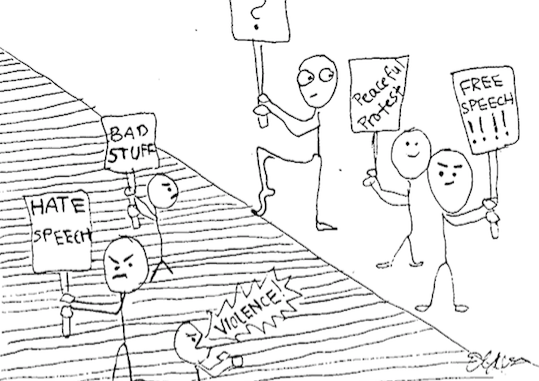
Last month, footage of a confrontation between the College Republicans and a group of minority students at Binghamton University went viral. In the video, which begins in the midst of the argument, the students can be heard arguing about whether or not the Republicans should be tabling on campus. At one point, students on the opposing side began dissembling the table. When things began to seem like they could possibly get out of hand, police stepped in and the 10-minute video ended with the chants of students: “Pack it up! Pack it up!”
Just days later, on Nov. 18, Binghamton made headlines again when students protested a talk by Dr. Arthur Laffer — a famed economist who worked under the Reagan administration — held by the College Republicans. This video showed students beginning to interrupt the talk before it could even begin, with Dr. Laffer being escorted out by security just minutes after the peaceful protest began.
The incidents at Binghamton came in the midst of another upstate school struggling with instances of hate speech. On Nov. 19, students studying in the library at Syracuse University began receiving a manifesto on their phones — the same manifesto used by the Christchurch massacre in New Zealand, The Washington Post reports. In the weeks prior to this incident, Syracuse had been dealing with an onslaught of hateful incidents: racial slurs posted on bulletin boards and shouted at students of color and swastikas drawn into the snow. The incidents became so frequent that minority students at the University launched a movement, “#NotAgainSU,” to demand action from administration.
The two situations cannot truly be compared, since one event had to do with protesting and the controversy surrounding that, and the other illustrates blatant racism and terrifying intolerance perpetuated throughout a campus. What happened at Syracuse University highlights the history of such behavior at the school as well, and the perpetuation of this conduct shows the University’s lack of attention and effective policies preventing it.
Still, these occurrences — all of which happened at nearly the same time as the others — have rejuvenated the national debate on free speech versus hate speech, and whether or not speech that could be considered as hateful has a place on our college campuses.
Hate speech, as defined by “Mass Media Law,” is “a communication that carries no meaning other than the expression of hatred for some group, especially in circumstances in which the communication is likely to provoke violence. It is an incitement to hatred primarily against a group of persons defined in terms of race, ethnicity, national origin, gender, religion, sexual orientation and the like.” As the law stands now, the government (including public colleges and universities) generally can’t bar hate speech unless it’s direct, personal and either truly threatening or violently provocative.
According to a statement released by the SUNY Board of Trustees and SUNY Chancellor, a task force has been formed with the primary function of brainstorming solutions to the growing problems in response to the recent incidents. There are also plans to convene all SUNY presidents and campus leaders to address the issues and find ways to ensure safety on campuses.
We at The New Paltz Oracle commend SUNY for taking steps towards change, and for making it a priority to listen to students and a goal to develop new policies and trainings on appropriate and efficient responses to intolerance. However, these changes need to be followed up with action that will actually bring about safer parameters for students. A situation like what happened at Syracuse, where students were sent home and classes were temporarily cancelled, should never be able to reach that point. College is meant to be someone’s home, and they deserve to feel safe and have open access to education in a productive environment that rejects hate, whether that university be public or private.
It is too often that historically underrepresented groups are asked to tolerate hate speech and rhetoric that actively insists on taking away their basic human rights. While the incident at Binghamton contains a lot of nuances, it is becoming a larger issue to continually request members of these communities to make room for hateful speech that targets them. Binghamton University released a statement after the incident on Nov. 20, explaining that they provided the protestors an “adjacent room for a counter discussion,” however, if there was an overwhelming amount of students at Binghamton University who rejected this speaker, then the on-site protest was rooted in a justified amount of outrage.
If the presence of Dr. Laffer made enough students uncomfortable, perhaps the College Republicans should’ve considered a different economist to speak on the campus that wasn’t associated with problematic ideals and people, since Dr. Laffer has ties to the Reagan administration — an administration riddled with controversy. To continuously provide a platform to individuals who promote harmful rhetorics is a mistake. The character and associations of a speaker are important criteria to consider when allowing someone to spread ideology on a public campus.
To shut down productive discourse, however, is also a mistake. We at The Oracle believe promoting tolerance is imperative to creating a political culture in which everyone feels safe to speak their mind. If a protest prevents a well-deserved speaker from sharing their thoughts, then that protest is preventing change from occurring. Rage is an essential catalyst for change, but so is active listening, questioning and understanding.
